Camera is an instrument used for taking photographs , making motion pictures , or transmitting images. A camera gathers light from the scene being photographed in a process called an exposure. This light is used to produce an image or series of images.
Historically, cameras captured images through the use of photographic film. This flexible, transparent plastic material has a light-sensitive coating that registers the scene being photographed. To produce an image, such film must be developed through treatment with chemicals in a photo lab. Film can capture a high level of detail. It is still used by some photographers today.
However, film-based cameras have been largely replaced by digital cameras. In a digital camera, the light strikes an image sensor. This device converts light into electronic signals. The sensor can be either a charge-coupled device (CCD) or a complementary metal-oxide semiconductor (CMOS). A built-in computer processes the signals to produce a digital image—that is, an image stored in the form of computer code.
This article explains how a camera takes pictures and discusses various types of cameras. For a discussion of the history and parts of a camera and how to take pictures, see the World Book article Photography . For information on making movies, see Motion picture and Camcorder . For information on cameras used in television production, see Television (Creating television signals) .
How a camera works
All cameras work according to the same basic principle. A camera is essentially a light-tight box—_that is, a chamber sealed to keep out unwanted light. In fact, the word _camera comes from a Latin term meaning chamber. During an exposure, light from the scene being photographed enters the camera.
The simplest cameras, called pinhole cameras, are boxes that make use of a small opening to gather and focus the light. Most cameras, however, gather and focus the light with the assistance of one or more curved pieces of glass or plastic called lenses . Lenses bend the light, focusing it onto the camera’s film or image sensor. The lens or pinhole projects an inverted (upside-down) image of the scene inside the camera.
Loading the player...How a film camera works
Positioning the camera.
Some cameras have a viewfinder, a small window that the photographer can look through to aim the camera. The viewfinder shows the edges of the photograph, enabling the photographer to frame (compose) the scene. In a digital camera, an electronic screen may be used instead of—or in addition to—a traditional viewfinder. The screen shows a preview of the image being captured.
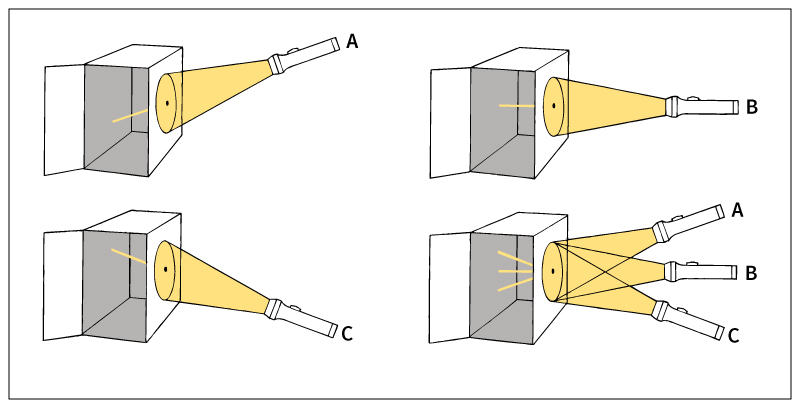
Focusing the image.
Producing a sharp image, rather than a fuzzy one, requires precise adjustment of the distance between a camera’s lens and the image sensor or film. The camera’s focusing mechanism makes fine adjustments to this distance. Most modern cameras can focus automatically. Professional cameras and prosumer cameras can be focused manually. A prosumer camera is less complex than a professional camera but more sophisticated than a consumer model, a model designed for everyday use. Manual focus enables the photographer to make decisions about which parts of the image will be in focus.
Controlling the exposure.
Two devices control the amount of light entering the camera during an exposure. They are the shutter and the aperture.
The shutter opens to admit light into the camera and closes again to end the exposure. It generally consists of a movable set of blades in the lens, or a curtainlike device between the lens and the image sensor or film. _Shutter speed—_how quickly the shutter opens and closes—determines how long the sensor or film is exposed. Shutter speed is measured in seconds and fractions of seconds. Many cameras have adjustable shutter speeds. They range from more than 1 second to less than 1/1,000 of a second.
The aperture is an adjustable opening inside the lens. The size of the aperture determines how much light reaches the image sensor or film when the shutter is open. Photographers describe aperture size using a number called f-stop. A higher f-stop number indicates a smaller opening, which admits less light into the camera. A lower f-stop number indicates a larger opening.
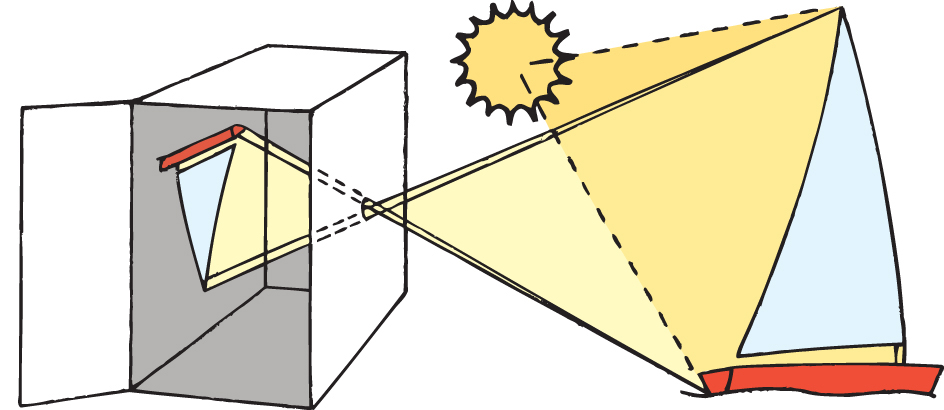
When taking a picture, photographers must balance shutter speed and aperture against each other to obtain sufficient light. To “freeze” a fast-moving object, for example, requires a short exposure time and thus a high shutter speed. The photographer must use a large aperture to let in enough light during this brief exposure. Using a large aperture, however, has a negative impact on the _depth of field—_that is, the amount of the scene that is in focus. A small aperture, by contrast, can result in a photograph with a long depth of field, in which are focused more objects at further distances from the camera.
In a digital camera, the image sensor’s sensitivity to light helps determine the outcome of an exposure. This sensitivity depends on the electronic properties of the sensor. Many digital cameras enable the photographer to adjust light sensitivity. Dark scenes, such as low light interiors or night shots, require a sensor to be set to capture the maximum amount of light possible. Such a setting can cause electronic noise, appearing as irregularities of bright and dark in the captured image. Many cameras have automatic noise reduction, which filters out this unwanted side effect.
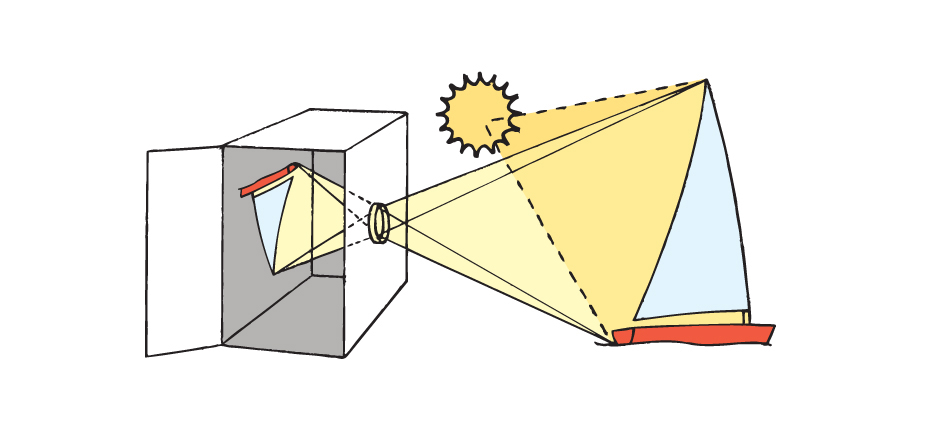
Providing additional light.
Many cameras have a built-in electronic flash unit that provides additional light to produce an adequate exposure. The flash unit provides a short burst of light timed to the opening of the shutter.
Storing a digital image.
Digital cameras save photographs as computer files. The files are usually stored on a removable memory card. Cameras that are built into phones, computers, and other devices typically make use of the device’s internal memory. Most memory cards and internal memory devices can store thousands of digital photos. The available computing power limits the speed with which the camera can record an image file. This speed limits how quickly exposures can be taken in succession.
Images are stored in a variety of file formats. TIFF (t_agged _i_mage _f_ile _f_ormat) is a file type used for making digital prints. JPEG (_J_oint _P_hotographic _E_xperts _G_roup) is a compressed file type usually used for viewing images on a computer monitor . _Raw image files have the highest resolution (fineness of detail) and are the most flexible image format. They most faithfully record the image data as captured by the sensor.
Automatic controls
Many cameras handle various aspects of the picture-taking process automatically. They do this through the use of a built-in computer called a central processing unit (CPU) or microprocessor . Sensors in the camera provide the computer with data, such as the amount of the light from the scene and the distance between the subject and the lens. The computer uses this information to determine the correct settings for focus and exposure. It either adjusts the camera automatically or displays information that helps the photographer set the camera manually. The three chief automatic controls are (1) automatic exposure control, (2) automatic focusing and (3) automatic white balance.
Automatic exposure control,
also called autoexposure, helps ensure proper exposure, including a proper range in tone between highlights, midtones, and shadows in the image. Many autoexposure systems have different modes for controlling the shutter speed, the aperture, or both. In an aperture-priority mode, the photographer manually sets the aperture. The camera automatically chooses a shutter speed appropriate for that aperture. Shutter-priority mode lets the photographer manually select the shutter speed. The camera automatically sets the aperture for proper exposure. Many cameras have automatic or program modes in which the camera chooses both the shutter speed and the aperture.
Autoexposure systems rely on readings from a built-in light meter , a device that measures incoming light. A set of instructions called a metering pattern tells the camera’s computer how to process light from various parts of the scene. The metering pattern helps the camera compensate for uneven lighting, as in a scene with a dark subject in front of a bright background.
Automatic focusing,
also called autofocus, adjusts the lens focus automatically to take sharp photographs. There are two chief types of automatic focusing systems: (1) active and (2) passive.
Active autofocus systems measure the distance to the subject, usually by sending out a beam of infrared light. Infrared light is a type of light invisible to the human eye. Sensors analyze the infrared light reflected from the subject to determine the subject’s distance. The camera’s computer automatically focuses the lens for this distance.
Passive autofocus systems analyze light from the subject after it has entered the camera. In most such systems, sensors behind the lens measure the contrast of lines or edges in the subject. This contrast is highest when the camera is sharply focused on the subject, so the system adjusts the focus to achieve high contrast.
Some autofocus systems can detect if a subject is moving. These systems adjust to keep the subject in focus during the instant the shutter is open.
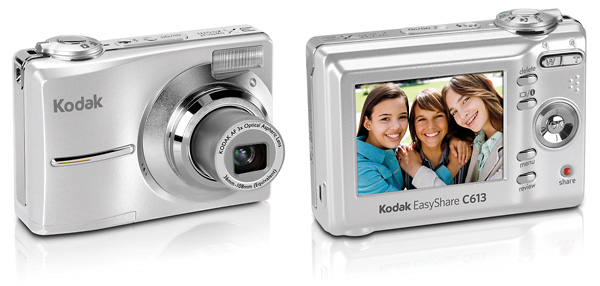
Automatic white balance,
also called automatic color balance, adjusts the color in an image to compensate for variations in white light. Most artificial light is not pure white. For example, incandescent household light bulbs emit a warm, yellowish light. Fluorescent bulbs can have a green tint. Outdoor daylight often appears blue. In a color photograph, differences in the color of light can make a subject appear unnatural. An automatic white balance system analyzes the colors of light collected by the image sensor. Using this information, the camera’s computer adjusts the image to compensate for variations in the color of light. It attempts to make the brightest highlights a pure white.
Types of cameras
Cameras come in a wide variety of designs. Some types are available in both digital and film models.
Point-and-shoot cameras
are simple to operate and have many automatic features. Most point-and-shoot cameras have autoexposure, autofocus, and a built-in lens. Typically, a viewfinder near the lens lets the photographer view the scene—though not the precise image captured by the lens. The lens is often a zoom lens, which can be adjusted to make a subject appear closer or farther away. Many point-and-shoot cameras also record video and audio in addition to still photographs. Point-and-shoot cameras are popular with casual photographers.
Single-lens reflex (SLR) cameras,
including digital models (DSLR’s), offer more complex features than point-and-shoot models. These cameras appeal to skilled amateur photographers as well as professionals. The camera’s name refers to its viewing system. In an SLR camera, a mirror between the lens and the image sensor or film reflects the image to the camera’s viewfinder. Thus, the photographer sees almost the exact image that will be recorded by the camera. When the photographer triggers the shutter, the mirror lifts out of the way, allowing the light to strike the image sensor or film.
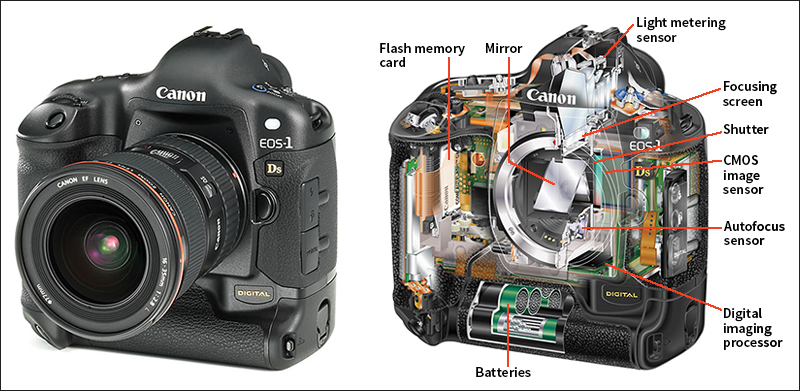
SLR cameras make use of interchangeable lenses. One type of lens, a wide-angle lens, provides a wider view of a scene than does a standard lens. A telephoto lens makes distant objects appear closer. A macro lens focuses on objects extremely close to the camera. Zoom lenses are popular because they can adjust from wide-angle to telephoto.
SLR cameras enable photographers to manually adjust the focus, shutter speed, and aperture. DSLR camera users can also adjust the white balance and the light sensitivity of the image sensor. Many DSLR cameras record high-definition video with audio in addition to high-resolution still photographs.
Mirrorless interchangeable-lens cameras (MILC’s)
are digital cameras that share many of the features of DSLR cameras, including the use of interchangeable lenses. But MILC’s lack a mirror system, instead focusing light directly onto a sensor.
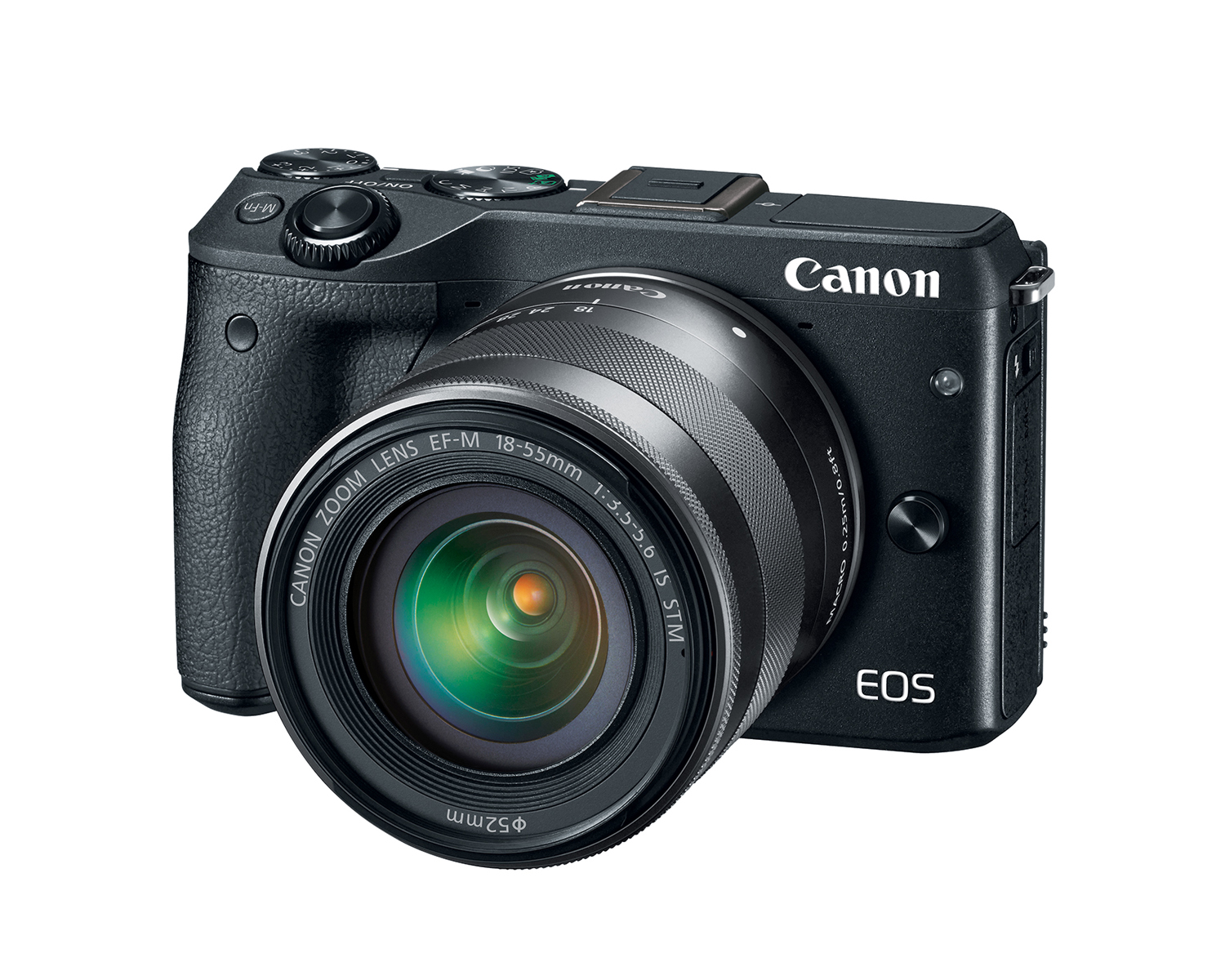
The lack of a moving mirror system prevents the user from seeing through the lens, as is possible with a DSLR camera. But it also enables mirrorless cameras to be smaller, lighter, quieter, and less complex than their DSLR counterparts. With a MILC, the photographer usually views the scene via an electronic screen on the rear of the camera, rather than through a viewfinder. However, the screen display can lag the scene being photographed, which may complicate the photographic process. Improvements in technology are decreasing this lag time, enabling MILC’s to compete with DSLR cameras.
View cameras
are the largest photographic cameras and the most adjustable in terms of focus and perspective. A view camera has two standards (supports). The front standard holds a lens and shutter. The rear standard holds the film or image sensor. A light-tight bellows connects the standards. The bellows is an accordionlike tunnel of adjustable length. The photographer focuses the camera by moving the standards back and forth to project a sharp image onto a glass plate. The shutter and aperture are usually built into the lens and can be adjusted by hand. The photographer then replaces the glass plate with a sheet of film or a large image sensor to take the picture.
High-resolution DSLR cameras and powerful image-processing software have replaced view cameras in most uses. However, some professional photographers still use film view cameras to produce portraits, architectural images, photographs of commercial products, and landscape photography.
Instant cameras
use film that does not require developing at a photo lab. The film contains the chemicals needed for developing and automatically develops itself soon after exposure. Instant cameras provide prints ranging in size from 2 by 3 inches (50 by 75 millimeters) to 20 by 24 inches (500 by 600 millimeters).
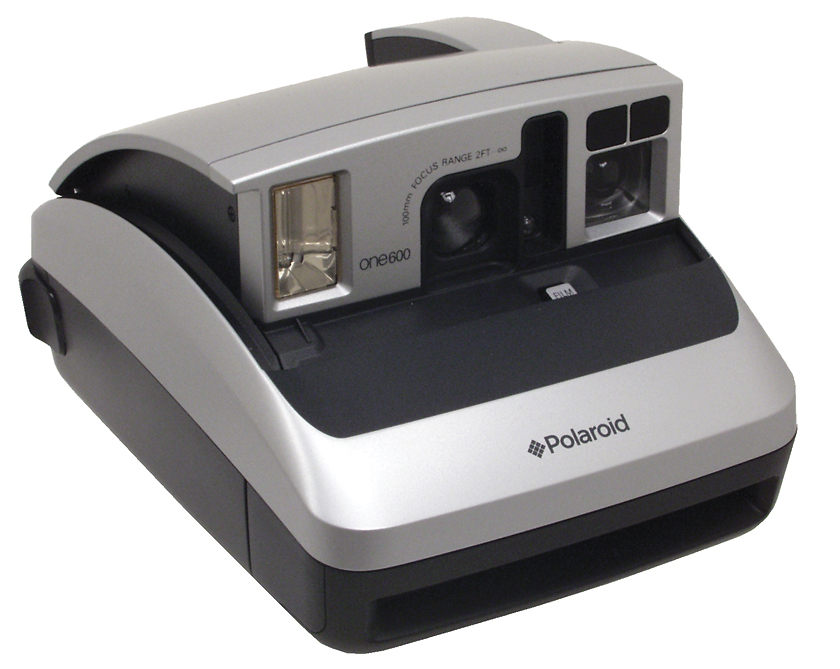
Motion-picture cameras
take a series of pictures that capture a subject’s motion. Professional moviemakers generally use large cameras that take 70-, 35-, or 16-millimeter film, or they use high-quality digital video cameras. Sound for professional movies is usually recorded separately and later merged with the film or video.
Some amateur moviemakers use portable video cameras called camcorders. Digital camcorders record on a storage device such as a videotape, memory card, or built-in storage drive. Camcorders can record sound at the same time as they record images. Most camcorders have a zoom lens.
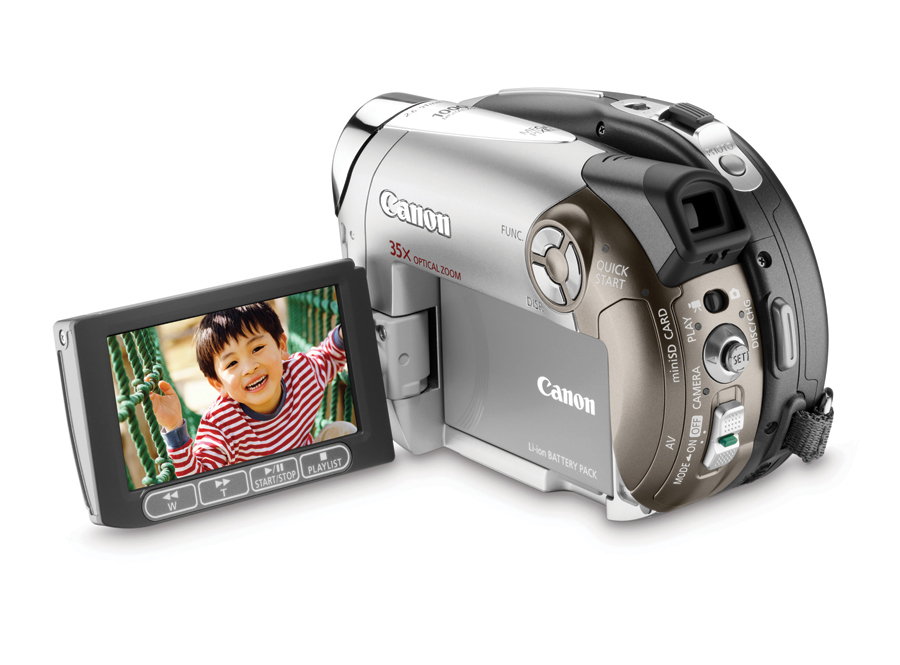
Stereo cameras
produce images that appear three-dimensional. One kind of stereo camera has two identical lens systems. It takes two pictures of the same subject from slightly different angles—one picture through each lens system. When viewed through special glasses or a device called a stereoscope , the two pictures blend into one image, creating the illusion of depth.
Phone cameras
are an increasingly common and important tool for photography. Like point-and-shoot cameras, cameras embedded in computerlike smartphones are designed to quickly and easily take pictures and videos. They also enable users to immediately share photos and videos over the Internet or via wireless networks. In aiming the shot, the smartphone’s screen displays a preview of the image, much like the screen on a MILC.
Smartphones have increasingly sophisticated photography editing software , often in the form of apps (applications). These programs can process images to enhance them or to create special effects.
